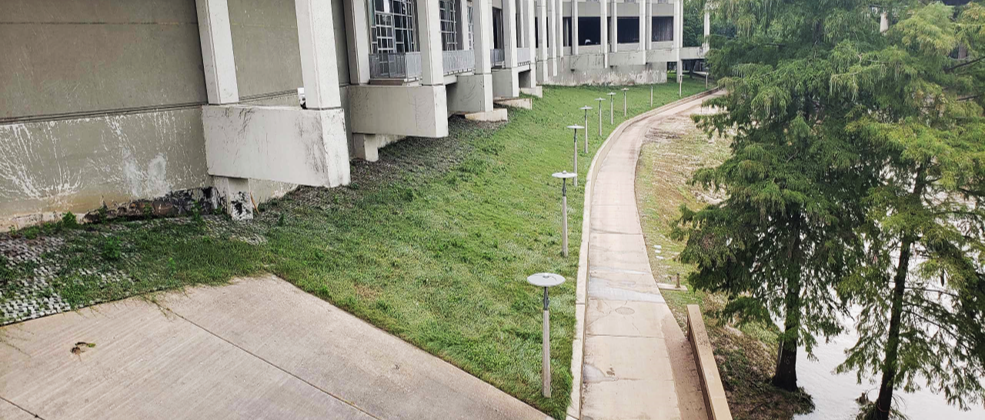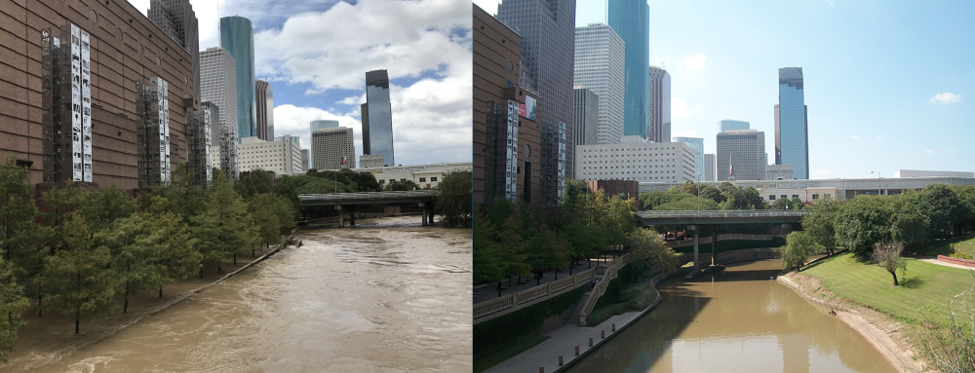
CASE STUDY: Buffalo Place
Restoring and Reinforcing Slopes in Houston’s Hurricane Country
While the weather may be unpredictable at times, one thing Houstonians can safely wager on is that Buffalo Bayou is going to flood again. Being the principle river in the Houston area, Buffalo Bayou collects the majority of stormwater runoff from the surrounding metro area, channels the water through downtown Houston and then drains into Galveston Bay. However, with the increase in urbanization and industrialization leading to a drastic increase in impervious surfaces, the days of Buffalo Bayou being a calm, flowing prairie river are over. At its worse during a storm, Buffalo Bayou becomes a strong force of nature between the sheer volume of water and the combined turbulence and speed of the water.
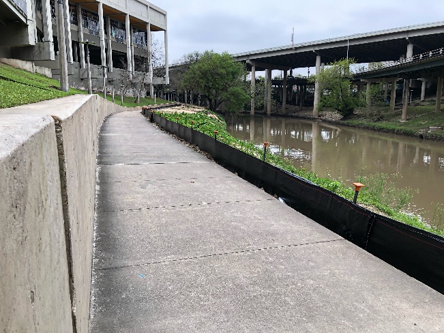 Atop a hillside overlooking a bend in the Bayou sits the commercial offices section of the Bayou Place building complex. At the bottom of the hillside just above the Bayou’s bank, a section of the scenic pedestrian walkway Buffalo Bayou Walk cuts across the property, separating the hillside and Bayou’s bank with a concrete walkway and hillside wall. At a glance, it would seem highly improbable that water could ever get above the hillside wall, let alone make it up the hillside to the building above – yet it has, on many occasions.
Atop a hillside overlooking a bend in the Bayou sits the commercial offices section of the Bayou Place building complex. At the bottom of the hillside just above the Bayou’s bank, a section of the scenic pedestrian walkway Buffalo Bayou Walk cuts across the property, separating the hillside and Bayou’s bank with a concrete walkway and hillside wall. At a glance, it would seem highly improbable that water could ever get above the hillside wall, let alone make it up the hillside to the building above – yet it has, on many occasions.
It was the flood water forces resulting from Hurricane Harvey that damaged both the hillside and building to the extent that the building needed to be closed. Four days of unrelenting downpour created an overwhelming amount of stormwater runoff that brought the rushing Bayou above the building’s foundation line, allowing the turbulent water to chip away at the building’s concrete base, as well as wash away layers upon layers of the hillside. As Harvey pulled away and the water receded, several large holes in the building wall became visible, meaning the entire underbelly of Bayou Place had been flooded and was now open to the elements. In addition, the once vegetated hillside below the building was decimated, leaving it vulnerable to erosion and now an unsightly section of Buffalo Bayou Walk. Houston First, the building’s management company, would need to repair the damage to both the building’s wall and the hillside.
Because Buffalo Bayou Walk cuts across the building’s hillside and is part of Houston’s nature park system, the Bayou Place renovation project was eligible to receive funds from FEMA’s Hurricane Harvey Relief Fund. Having oversight of how the FEMA funds are to be spent, this meant that the City of Houston was now integral to the decision-making process of what the hillside erosion control and beautification solution would be.
Walter P. Moore Engineers, the engineer of record, originally planned to pave the entire hillside, creating what is known as a “hard armor” solution. However, the City of Houston felt that the hard armor erosion control solution was both cost-prohibitive and would simply conflict with keeping Buffalo Bayou Walk a scenic walkway. That’s when Walter P. Moore approached Construction EcoServices to develop a cost-effective, Green Stormwater Infrastructure (GSI) solution that could withstand strong future flooding.
Construction EcoServices went to work developing the solution, performing soil tests and calculations involving slope angle, water volume, turbulence and speed, matched against aesthetic goals and maintenance requirements. In addition, because of the clear overlaps in the wall and slope repair processes, Construction EcoServices was asked to also assume responsibility for the building’s repair. Several weeks later, Construction EcoServices presented a comprehensive solution plan to the stakeholders, with the 4-month timeline starting with the building repair work and ending with the initial vegetative growth and stabilization of the hillside.
Project work began by deeper exploration of the exact scale of vulnerable void space under the building now accessible to water and other elements through the open holes in the building wall. The workers who crawled in under the building noted that one void space led to another, all of which would need to be filled in with concrete to ensure the building’s stability. An additional challenge came from there being no easy access to pump the flow fill into the building’s underbelly, as the required machinery was too large to utilize the pedestrian walkway at the bottom of the hillside. In the end, 85 cubic yards of flowable fill was piped under the building from a truck parked high up on a segment of bridge 100-feet away, allowing gravity to assist in pumping flow through the long hose. With the void space filled and the building wall holes sealed and patched, project focus turned to the hillside’s renovation.
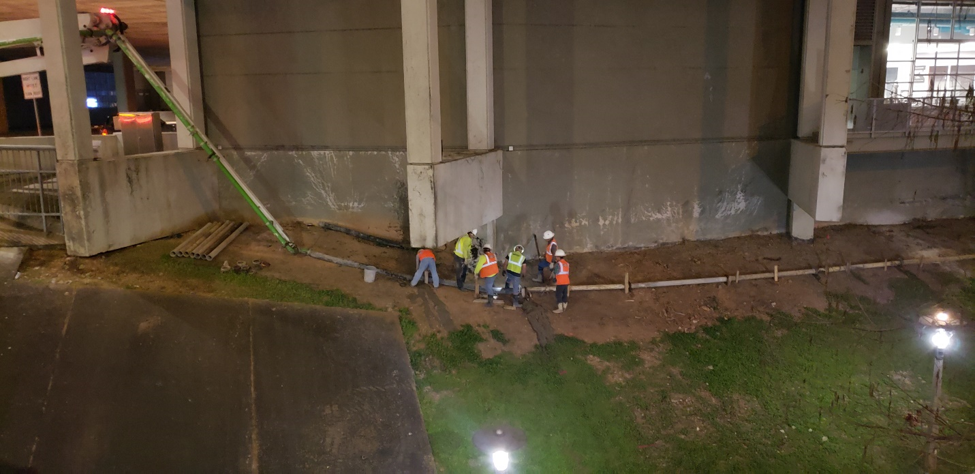 Understanding the force it took for the water to wash out the holes in the building’s concrete wall, Construction EcoServices recommended laying Articulated Concrete Blocks from against the base of the building’s wall, down the slope approximately 12 feet. This would be additional insurance for keeping the upper part of the hillside from washing away, even in the most turbulent flooding that may come. Further, while this section of the erosion control solution could be considered “hard armor”, the type of blocks that were used have holes allowing vegetation to grow through, thereby eventually hiding the blocks under aesthetically pleasing cover.
Understanding the force it took for the water to wash out the holes in the building’s concrete wall, Construction EcoServices recommended laying Articulated Concrete Blocks from against the base of the building’s wall, down the slope approximately 12 feet. This would be additional insurance for keeping the upper part of the hillside from washing away, even in the most turbulent flooding that may come. Further, while this section of the erosion control solution could be considered “hard armor”, the type of blocks that were used have holes allowing vegetation to grow through, thereby eventually hiding the blocks under aesthetically pleasing cover.
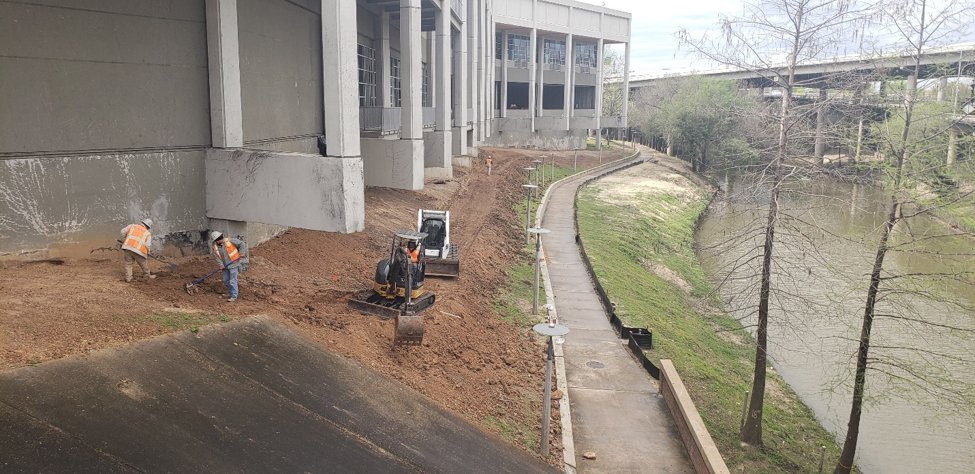 Again, the site location proved problematic. Being inaccessible to large vehicles or equipment, all materials, including three thousand Articulated Concrete Blocks, would need to be staged a quarter mile away and hauled in by small equipment or by hand down the walkway. Further, the three thousand blocks would need to then get up the hillside to be placed against the building. Taking into account potential damage to the hillside’s existing irrigation system, as well as the additional time, effort and costs to do it, it was determined best to cut a temporary roadway into the hillside to allow a skid steer to drop off the pallets of blocks close to where the block’s final resting places would be.
Again, the site location proved problematic. Being inaccessible to large vehicles or equipment, all materials, including three thousand Articulated Concrete Blocks, would need to be staged a quarter mile away and hauled in by small equipment or by hand down the walkway. Further, the three thousand blocks would need to then get up the hillside to be placed against the building. Taking into account potential damage to the hillside’s existing irrigation system, as well as the additional time, effort and costs to do it, it was determined best to cut a temporary roadway into the hillside to allow a skid steer to drop off the pallets of blocks close to where the block’s final resting places would be.
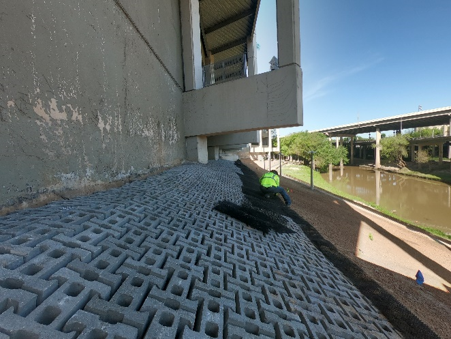 G-Tex Construction, experts in site work, excavation and grading, created the roadway and began hauling in the pallets of blocks. Starting at the far east end of the slope, each block was manually set into place, laid on top of Futerra® Turf Reinforcement Mat (TRM). The Futerra® 7020 mat was used under the blocks to keep the consistency of the TRM down the slope. Five days and three flatbed truckloads of blocks later, a solid 12×250’ long section at the top of the slope was covered with the blocks, the temporary road filled in and the remaining slope grated and made ready for the next stage.
G-Tex Construction, experts in site work, excavation and grading, created the roadway and began hauling in the pallets of blocks. Starting at the far east end of the slope, each block was manually set into place, laid on top of Futerra® Turf Reinforcement Mat (TRM). The Futerra® 7020 mat was used under the blocks to keep the consistency of the TRM down the slope. Five days and three flatbed truckloads of blocks later, a solid 12×250’ long section at the top of the slope was covered with the blocks, the temporary road filled in and the remaining slope grated and made ready for the next stage.
Teaming up with Profile Products, Construction EcoServices and Profile carefully analyzed the soil test results and determined that the soil was going to need amendments in order to ensure a more favorable growing environment for faster, more complete and sustainable vegetation. The soil test showed basic soils with 8.5 pH and low organic matter of 1.2 percent. Profile and Construction EcoServices determined they would need to apply ProGanics® Biotic Soil Media™, an Engineered Soil Media™ that accelerates the development of depleted soils with low organic matter, nutrient levels and limited biological activity. In addition to adding Bermuda grass seed into the ProGanics, Construction EcoServices also recommended adding a specific mix of Profile’s ProPlus® Prescriptive Solutions, including Aqua-pHix™, JumpStart™ and BioPrime™. Aqua-pHix modifies alkaline soils, JumpStart accelerates germination and vegetation establishment, and BioPrime is designed to rejuvenate poor soils and enhance long-term vegetation sustainability.
When asked about using these Profile products at this stage of the project, John Moss, Director of Business Development at Construction EcoServices commented, “ProGanics is simply a gamechanger. We’ve had a lot of success with it especially when dealing with importing topsoil or deficient, difficult-to-install topsoil.” Moss also added, “We’re big fans of ProGanics and all the other erosion control products Profile provides. In fact, we only recommend Profile products even though we can distribute anything we want.”
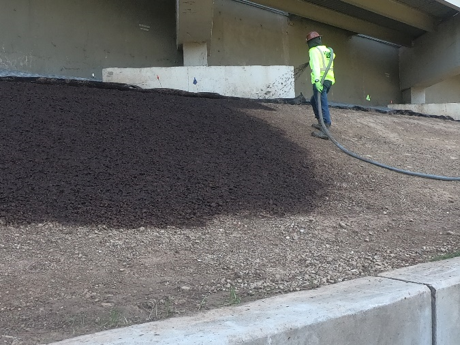 K-4 Environmental, an expert hydroseeding sub-contractor, was hired to hydroseed the various Profile products onto the hillside. However, once again the pedestrian walkway proved too narrow to allow passage of the hydroseed truck, so the truck had to park on the bridge high above the eastern side of the slope. However, unlike the concrete fill, the hydroseed products would need to be pumped over five hundred feet to the furthest point of the opposite side of the slope. By slightly thinning the mix, plus getting some help from gravity, the various hydroseeding products were able to be successfully pumped through hundreds of feet of hose. For this initial layer to the erosion control solution, K-4 Environmental applied the ProGanics at a rate of 5,000 pounds per acre, Aqua-pHix at 10 gallons per acre, JumpStart at 2.5 gallons per acre, and BioPrime at 80 pounds per acre.
K-4 Environmental, an expert hydroseeding sub-contractor, was hired to hydroseed the various Profile products onto the hillside. However, once again the pedestrian walkway proved too narrow to allow passage of the hydroseed truck, so the truck had to park on the bridge high above the eastern side of the slope. However, unlike the concrete fill, the hydroseed products would need to be pumped over five hundred feet to the furthest point of the opposite side of the slope. By slightly thinning the mix, plus getting some help from gravity, the various hydroseeding products were able to be successfully pumped through hundreds of feet of hose. For this initial layer to the erosion control solution, K-4 Environmental applied the ProGanics at a rate of 5,000 pounds per acre, Aqua-pHix at 10 gallons per acre, JumpStart at 2.5 gallons per acre, and BioPrime at 80 pounds per acre.
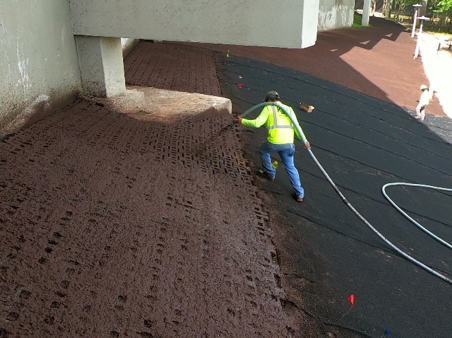 As an additional quality measure, Construction EcoServices had K-4 also spray this layer into the open spaces of the Articulated Concrete Blocks. While it was planned to later plant Jasmine sprigs in the block open spaces, this added layer of seed infused ProGanics would ensure a quick vegetated covering of the blocks while the Jasmine matured.
As an additional quality measure, Construction EcoServices had K-4 also spray this layer into the open spaces of the Articulated Concrete Blocks. While it was planned to later plant Jasmine sprigs in the block open spaces, this added layer of seed infused ProGanics would ensure a quick vegetated covering of the blocks while the Jasmine matured.
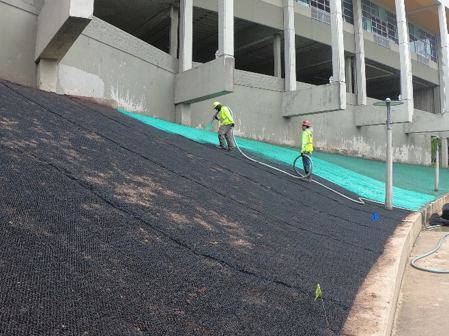 With the soil amendments applied, K-4 Environmental proceeded to the next stage, installing an erosion control system called GreenArmor, which is Futerra TRM infilled with Flexterra. The Futerra TRM provides a permanent, lofty and open matrix that is then hydraulically infilled with Flexterra® High Performance-Flexible Growth Medium®. Flexterra quickly and intimately bonds soil and seeds, accelerates growth and adds additional protection against hydraulic lift and shear forces. Moss commented, “The combination of the permanent TRM with Flexterra provided the added erosion control effectiveness that the site needed against velocities like those that Hurricane Harvey brought to the area.” He continued, “We’ve always tried to use GreenArmor where riprap or hard armor might be prescribed simply because we think it’s a better solution.”
With the soil amendments applied, K-4 Environmental proceeded to the next stage, installing an erosion control system called GreenArmor, which is Futerra TRM infilled with Flexterra. The Futerra TRM provides a permanent, lofty and open matrix that is then hydraulically infilled with Flexterra® High Performance-Flexible Growth Medium®. Flexterra quickly and intimately bonds soil and seeds, accelerates growth and adds additional protection against hydraulic lift and shear forces. Moss commented, “The combination of the permanent TRM with Flexterra provided the added erosion control effectiveness that the site needed against velocities like those that Hurricane Harvey brought to the area.” He continued, “We’ve always tried to use GreenArmor where riprap or hard armor might be prescribed simply because we think it’s a better solution.”
Using mallets and sod staples, K-4 Environmental workers manually secured the Futerra TRM to the entire remaining hillside below the blocks and readied the slope for the Flexterra infilling. The mat was then infilled with Flexterra at a rate of 4,000 pounds per acre and included Bermuda seed.
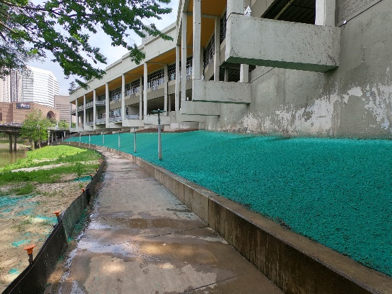 Lastly, the Jasmine sprigs were planted into the Articulated Concrete Blocks and the project site was cleaned.
Lastly, the Jasmine sprigs were planted into the Articulated Concrete Blocks and the project site was cleaned.
In the weeks following project completion, Construction EcoServices reported that the site had good initial germination and within several weeks had strong vegetation. “We are very pleased with the results. It came in exactly as expected,” Moss said. He then added, “We didn’t do a cover crop because we didn’t want anything competing with the Bermuda, so we expected it to take a little longer to grow in than with a cover crop. But it has filled in perfectly.”
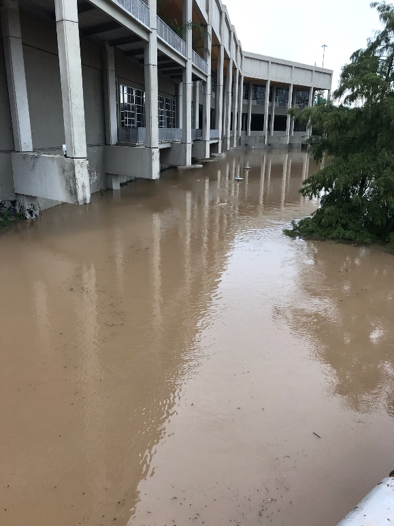 Then, in September 2019, three months after completion, the site went through its first real test when Tropical Storm Imelda dropped 42 inches of rain in Houston. A nearly exact repeat of Harvey, the Bayou once again flooded and strong, turbulent waters traveled up the hillside to the building ‘s foundation line. However, when the flood water receded, it was clear that this time the GreenArmor System had held the slope in place, proving the solution a success. Moss attributes this success to the combination of Flexterra and the TRM. “I don’t think there could have been a better confirmation of the design, execution and installation than having it tested like that that soon after being built,” Moss said. “I have to admit, I was sweating a little bit, but the outcome was exactly what we wanted, so no complaints. There’s no question that the GreenArmor System worked great. Without that, there would have been damaged slope I’m sure to some degree. I think what this proves is that there’s a green solution for even the most challenging situations.”
Then, in September 2019, three months after completion, the site went through its first real test when Tropical Storm Imelda dropped 42 inches of rain in Houston. A nearly exact repeat of Harvey, the Bayou once again flooded and strong, turbulent waters traveled up the hillside to the building ‘s foundation line. However, when the flood water receded, it was clear that this time the GreenArmor System had held the slope in place, proving the solution a success. Moss attributes this success to the combination of Flexterra and the TRM. “I don’t think there could have been a better confirmation of the design, execution and installation than having it tested like that that soon after being built,” Moss said. “I have to admit, I was sweating a little bit, but the outcome was exactly what we wanted, so no complaints. There’s no question that the GreenArmor System worked great. Without that, there would have been damaged slope I’m sure to some degree. I think what this proves is that there’s a green solution for even the most challenging situations.”
